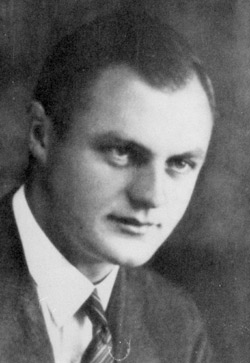Eduard Wirths facts for kids
Quick facts for kids
Eduard Wirths
|
|
|---|---|
 |
|
| Born | 4 September 1909 Geroldshausen, German Empire |
| Died | 20 September 1945 (aged 36) Staumühle, Allied-occupied Germany |
| Allegiance | Nazi Germany |
| Service/ |
Schutzstaffel |
| Years of service | 1933–1945 |
| Rank | SS-Obersturmbannführer |
| Commands held | Formal responsibility of medical staff at Auschwitz; human medical experimentation performed on prisoners at Auschwitz |
| Awards |
|
| Spouse(s) | Gertrud Petavy |
| Children | 4 |
Eduard Wirths (born September 4, 1909 – died September 20, 1945) was a doctor during World War II. He was the main SS doctor at the Auschwitz concentration camp from 1942 to 1945. This meant he was in charge of all the other SS doctors there, including famous ones like Josef Mengele. These doctors worked in the medical parts of Auschwitz.
Contents
Early Life and Family
Eduard Wirths was born in 1909 in Geroldshausen, a town in Germany. His family was Catholic. His father was a medical helper in the First World War. He wanted all his sons to become doctors. Eduard was known for being very careful, obedient, and dependable. He did not smoke or drink. His family was not known to dislike Jewish people or support extreme political ideas.
Joining the Nazi Party
While studying medicine at the University of Würzburg (1930–1935), Eduard Wirths became a strong supporter of the Nazis. He joined the Nazi Party in June 1933. He also joined the SA, which was a Nazi group. In 1934, he applied to join the SS, another powerful Nazi organization.
In 1939, he joined the Waffen SS, which was the fighting branch of the SS. He fought in Norway and on the Russian Front. In 1942, he had a heart attack and was found unable to fight. After this, Wirths chose to get special training for leaders at the Dachau concentration camp. He then worked as the main SS doctor at the Neuengamme concentration camp in July 1942.
Eduard Wirths at Auschwitz (1942–1945)
In September 1942, Wirths was made a captain (SS-Hauptsturmführer). He was then appointed as the chief doctor at Auschwitz concentration camp. He got this job because he was seen as a skilled doctor and a dedicated Nazi. His main task was to stop the spread of typhus disease. This disease was affecting many SS staff members at Auschwitz.
At Auschwitz, Wirths was known for protecting prisoner doctors. He also tried to improve conditions in the medical areas for prisoners. Many prisoner doctors and inmates who met him remembered him in a good way.
Rudolf Höss, who was the commander of Auschwitz from 1940 to 1943, thought highly of Wirths. He once said that in his ten years of working in concentration camps, he had never met a better doctor.
In 1943, a political prisoner named Langbein, who worked with Wirths, sent him a Christmas card. The card said that Wirths had saved the lives of 93,000 people that year. This number was based on how much the death rate from typhus had dropped since Wirths arrived.
Medical Experiments on Prisoners
Wirths was involved in ordering medical experiments on prisoners. These experiments often focused on women's health and typhus-related tests. Wirths's main research looked at growths that could become cancer in the cervix.
Choosing Prisoners for Death
Wirths also took control of choosing prisoners for death at the Auschwitz-Birkenau camp. Before spring 1943, the camp commander made these choices. Wirths insisted on taking his turn in performing these selections. He could have let other doctors do it, but he chose to do it himself.
During the trial of Adolf Eichmann, it was shown how the SS recorded prisoner deaths. Prisoners who died in Auschwitz were always recorded as dying from natural causes. Their deaths were never listed as executions or murders. This did not include those who were immediately killed in gas chambers. Their entry was simply not recorded.
In September 1944, Wirths was promoted to major (SS-Sturmbannführer). After Auschwitz was emptied in January 1945, he was moved to the Mittelbau-Dora concentration camp. He was again the chief camp doctor there until that camp was also emptied in April 1945.
Wirths's Role in the SS
Historian Robert Jay Lifton said that Wirths strongly believed in Nazi ideas. These ideas included making the German people stronger and healthier. They also focused on getting rid of Jewish people, who the Nazis saw as a threat. Wirths also had a strong sense of medical duty. His commitment to the Nazi cause was very strong.
Wirths often drove around Auschwitz in a car with a Red Cross flag. He also liked to help other SS staff with their personal problems. According to Helgard Kramer, Wirths wanted to become a military doctor in the SS because he wanted to be part of the upper class. He wanted to provide a good life for his future wife. To do this, he felt he had to become a "tough man."
SS Ranks and Awards
- Ranks
- September 1942: Promoted to SS-Hauptsturmführer (Captain)
- September 1944: Promoted to SS-Sturmbannführer (Major)
- Final rank in the SS: SS-Obersturmbannführer (Lieutenant Colonel)
- Awards
- War Merit Cross 1st Class With Swords
- Iron Cross 2nd Class 1939
- DRL-Sports Badge in Bronze
- German Social Welfare Medal 2nd Class
- Eastern Front Winter Medal
See also
- Hans Münch
Images for kids


